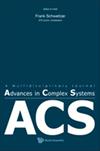The Talent versus luck Model as an Ensemble of One-dimensional Random Walks
IF 1
4区 数学
Q4 MATHEMATICS, INTERDISCIPLINARY APPLICATIONS
引用次数: 1
Abstract
The role of luck on individual success is hard to be investigated empirically. Simplified mathematical models are often used to shed light on the subtle relations between success and luck. Recently, a simple model called “Talent versus Luck” showed that the most successful individual in a population can be just an average talented individual that is subjected to a very fortunate sequence of events. Here, we modify the framework of the TvL model such that in our model the individuals’ success is modelled as an ensemble of one-dimensional random walks. Our model reproduces the original TvL results and, due to the mathematical simplicity, it shows clearly that the original conclusions of the TvL model are the consequence of two factors: first, the normal distribution of talents with low standard deviation, which creates a large number of average talented individuals; second, the low number of steps considered, which allows the observation of large fluctuations. We also show that the results strongly depend on the relative frequency of good and bad luck events, which defines a critical value for the talent: in the long run, the individuals with high talent end up very successful and those with low talent end up ruined. Last, we considered two variations to illustrate applications of the ensemble of random walks model.作为一维随机漫步集合的天赋与运气模型
运气对个人成功的作用很难进行实证研究。简化的数学模型经常被用来揭示成功和运气之间的微妙关系。最近,一个名为“天赋vs运气”的简单模型表明,人口中最成功的个体可能只是一个普通的有天赋的个体,他受到了一系列非常幸运的事件的影响。在这里,我们修改了TvL模型的框架,这样在我们的模型中,个体的成功被建模为一维随机游走的集合。我们的模型再现了原始的TvL结果,由于数学上的简单性,它清楚地表明,TvL模型的原始结论是两个因素的结果:第一,低标准差的人才正态分布,产生了大量的平均人才个体;其次,考虑的步骤数少,这使得可以观察到大的波动。我们还表明,结果在很大程度上取决于好运和坏运气事件的相对频率,这为天赋定义了一个临界值:从长远来看,拥有高天赋的人最终会非常成功,而那些拥有低天赋的人最终会破产。最后,我们考虑了两种变体来说明随机漫步集合模型的应用。
本文章由计算机程序翻译,如有差异,请以英文原文为准。
求助全文
约1分钟内获得全文
求助全文
来源期刊

Advances in Complex Systems
综合性期刊-数学跨学科应用
CiteScore
1.40
自引率
0.00%
发文量
121
审稿时长
6-12 weeks
期刊介绍:
Advances in Complex Systems aims to provide a unique medium of communication for multidisciplinary approaches, either empirical or theoretical, to the study of complex systems. The latter are seen as systems comprised of multiple interacting components, or agents. Nonlinear feedback processes, stochastic influences, specific conditions for the supply of energy, matter, or information may lead to the emergence of new system qualities on the macroscopic scale that cannot be reduced to the dynamics of the agents. Quantitative approaches to the dynamics of complex systems have to consider a broad range of concepts, from analytical tools, statistical methods and computer simulations to distributed problem solving, learning and adaptation. This is an interdisciplinary enterprise.
 求助内容:
求助内容: 应助结果提醒方式:
应助结果提醒方式:


